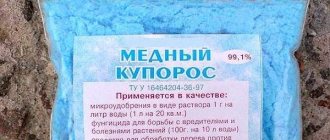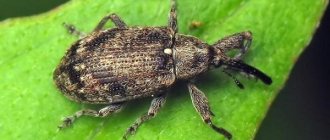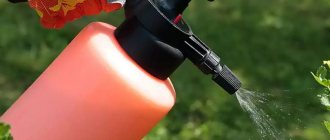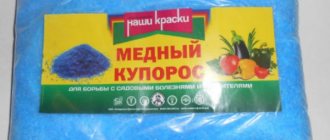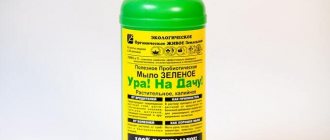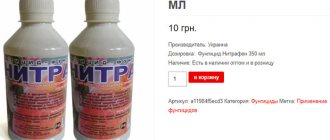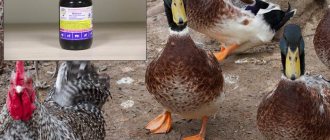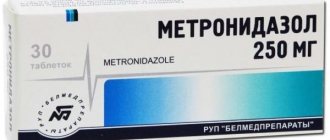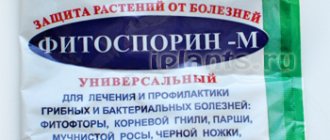Copper sulfate: composition and beneficial properties
Chemical formula of copper sulfate:
CuSO4.
It is formed as a result of the combination of copper and its oxide with sulfuric acid. In its original composition, it is a powder of crystals, which, when combined with air and absorbing moisture, acquires a rich blue, azure color. Copper sulfate contains 24% copper.
Photo of the drug copper sulfate
There is different information on the hazard class. More often you can find copper sulfate classified as class 4 (“low-hazardous substance”). Less often – to the 3rd – “moderately hazardous substances”.
If even a small dose enters the body, poisoning can occur. In any case, the instructions for using copper sulfate must be followed exactly.
Characteristics of copper sulfate:
- metallic taste;
- high absorption;
- no smell;
- good ability to dissolve in water, highly concentrated sulfuric acid solutions, alcohol;
- rapid decomposition at high temperatures from 100 to 250 degrees;
- outdoor weathering;
- Shelf life: 2 years (store only in a dry place).
Properties and composition
Copper sulfate is an inexpensive preparation that is sold in hardware stores and organizations that sell products for plant growers. It is sold in the form of blue or deep blue crystals.
When the crystalline substance is heated, the liquid evaporates from them and they acquire a lighter shade. With prolonged heating, the substance acquires a faded gray color. Copper sulfate is a non-flammable material, but in some situations it is explosive.
The properties of crystallized copper sulfate are as follows:
- the substance quickly dissolves in liquid;
- quickly absorbs water – significant hygroscopicity;
- dissolves in alcohol and hydrochloric acid.
Copper sulfate is a strong toxic substance, the handling of which requires extreme caution and absolute adherence to safety regulations.
Attention!
If copper sulfate enters the human body, it leads to serious poisoning; if small amounts are swallowed, you must immediately rinse the stomach and call emergency medical attention.
What can be treated with copper sulfate
The scope of application of copper sulfate is quite extensive.
It is mainly used in the following cases:
- when fungus or mold, rust forms on leaf blades, stems and other parts of plants;
- carrying out spraying to destroy insects and pests, as well as to eliminate plant diseases;
- for soil disinfection for preventive and therapeutic purposes;
- enrichment of soil depleted in copper (for example, peat soils).
Photo of the appearance of copper sulfate
Modern store shelves offer a huge number of new products for exactly the same purposes. Copper sulfate has already become an “old-fashioned” method that has sunk into oblivion. However, you shouldn’t rush to put it away in a drawer, as it has a lot of advantages that will help solve many problems associated with gardening.
Advantages:
- affordable price;
- wide range of applications, including a range of pathogens;
- there is no addiction among pests and bacteria, which allows you to use copper sulfate several times in a row and there is no need to search for new products;
- has a low level of danger to pollinating insects and humans.
FUNGICIDES!
Impact fungicide Preparation Fundazol Fungicide Antrakol
Disadvantages:
- Exceeding the consumption standards for copper sulfate and violating the rules of use leads to toxicity to humans and plants;
- high degree of acidity (even a small amount of the substance acidifies the soil).
Attention!
To reduce acidity, lime is added along with copper sulfate. This option has its drawbacks, including the appearance of chlorosis. It occurs due to the death of bacteria, which occurs as a result of excess copper in the soil.
To smooth out the negative impact of copper sulfate on the soil, it is recommended to spray.
Water only on rare occasions.
Processing times
Spring
- The first treatment is done at the beginning of the gardening season, when the night temperature does not drop below 5⁰C. Solutions are prepared in a concentration of 0.5 g/l and watered generously with them, in a volume of no less than 3.5-4.0 liters per square meter. In fruit and berry plantings, before buds open, a 1% solution is used for the same diseases. Its use will also give good results against fruit rot and black cancer. The treatment is done by spraying.
- A good measure to prevent plant diseases is short-term, up to 3 minutes, soaking the root system of seedlings in a 1% solution. Only then must the roots be washed in clean water. In the absence of running water, wash in at least 3 waters, with intensive rinsing in them. Such manipulation of seedlings ensures guaranteed disinfection of their root part.
- To prevent infection of the future crop with late blight, sorted potato tubers laid out in one layer are sprayed with a 0.2% solution of copper sulfate. After this treatment of one side, turn over the planting material and spray it again. This treatment is done 3-4 times, waiting for the solution drops to completely dry after each turning and spraying.
- It is advisable to soak the seeds in a 0.2% warm solution for early germination. The seeds of all plants, except cucumbers, are soaked for 20-24 hours. Cucumber seeds only for 6-8.
- “Suspicious” seeds of tomatoes and pumpkins or cucumbers should be treated with the following mixture: 1 g of vitriol + 2 g of boric acid + 8 g of potassium permanganate + 10 liters of warm water. Dilute all components of the solution in the specified sequence. The seeds are soaked in a liquid of this composition for 15 minutes at a temperature of 25 degrees, and then washed in running water.
Summer
- To prevent late blight and eliminate copper deficiency in nightshades, a 0.2% solution is made from copper sulfate and water. Its consumption per 1 sq. a meter of soil will be about 2-3 liters, with the treatment repeated after 2-4 weeks.
- Damage to the bark of fruit trees is treated with a 1% solution, and of shrubs - with a 0.5 percent solution.
Autumn
Basically, exposure to copper sulfate in the fall is necessary for preventive purposes, after the harvest has been harvested and the territory has been sanitized. Why at this time?
- Burns of leaves due to the strong acidic reaction of the substance are excluded. The use of copper sulfate will inevitably increase the acidity of the soil, which will force you, along with the use of copper sulfate, to do a little liming.
- The autumn use of copper-containing preparations is also useful because the greatest need for them and the best absorption of copper occurs at the beginning of the season, during the period of vigorous growing season. And in the fall, perennial plants, on the eve of hibernation, will not consume copper from the vitriol molecule, and after its inevitable destruction, the metal will remain in the soil until spring, at the same time acquiring a form more acceptable for absorption. And most importantly, the vitriol will not penetrate into plant tissue. The same applies to fungi, against which the product acts as a fungicide, affecting their reproductive, spore-ripening tissues.
During the entire period from April to October, the site is treated in dry and windless weather, in a temperature range from +5 to +30 degrees, not higher.
How to prepare a solution of copper sulfate for processing (1%, 3%, 5%)
Making your own solution with copper sulfate is easy. Even an inexperienced gardener can do this.
Photo of copper sulfate crystal
Rules for preparing a solution of copper sulfate:
- to dilute the powdered mass, use only enamel or glass containers (containers made of other materials, such as aluminum, will reduce the beneficial qualities of the substance);
- for better dissolution, take water at room temperature;
- the solution must be carefully filtered through cheesecloth before use.
Biological products for the garden and vegetable garden:
Actofit Gliokladin Fitoverm
Preparation of a 1% solution of copper sulfate
A 1% solution is prepared at the rate of 100 grams of product per 10 liters of water. It is carefully filtered through gauze cloth. Add a little lime (in a 1:1 ratio with copper sulfate) to obtain a Bordeaux mixture.
This composition is used for fertilizer. A small concentration of the substance is quite sufficient to saturate the soil with a lack of copper. Fertilize in the spring. For 1 m2 you need 4 liters of solution.
Photo of preparing copper sulfate
The solution is prepared as follows:
- 100 grams of copper sulfate are stirred in water (1 liter volume).
- Lime is diluted separately in an amount of 150 g per 1 liter of water.
Add an additional 4 liters of water to each container and stir thoroughly. Insist for a quarter of an hour. Combine the solutions in one container.
Important!
No more water is added to the finished solution!
Preparation of a 3% solution of copper sulfate
A solution with a 3% content is used for both prevention and treatment.
It is used when the first signs of disease or pest damage are detected. It is also used to treat cracks and damage to tree bark.
The best time to spray with 3% copper sulfate is spring, before the buds have yet opened.
It is also used before planting seedlings for the purpose of prevention. To do this, place the roots of the seedlings in Bordeaux mixture for a couple of minutes. After the procedure, moisten with plenty of water to wash off the substance.
This solution is used to lubricate cracks and damage on tree bark. It's better to do this in the summer.
The solution is prepared as follows:
- In a plastic container or glass jar, dilute 300 grams of copper sulfate in 2 liters of water.
- Separately, prepare “milk” from lime in the amount of 350 grams of lime per 1.5 liters of water.
- Add 5 liters to each container.
The solution with lime is filtered through cheesecloth, after which diluted copper sulfate is gradually poured into it. Stir continuously.
Attention!
To check the balance of acids and alkalis, use simple litmus paper. If the stripe is blue, the balance is normal; if the paper is colored red, additional lime is added.
Insecticides:
Akarin Kinmiks
Preparation of a 5% solution of copper sulfate
The prepared mixture containing 5% copper sulfate is called “burning out”.
It is used when it is necessary to disinfect the entire area of the garden plot. Typically, treatment with a 5% solution of copper sulfate occurs in the fall. After such treatment, mold and microorganisms that cause the disease are instantly eliminated.
After treatment with a solution of copper sulfate in 5%, the land is used for planting no earlier than after 1 year.
The process of preparing the solution:
- The process of preparing the solution is similar to that described above. First, make a separate solution with the addition of lime (500 grams per 1/2 liter of water, then add up to 4 liters of water).
- Separately, make a solution with copper sulfate in the amount of 500 ml per 1/2 liter of water, adding up to 5 liters of water. Leave for half an hour, then combine both solutions into one, carefully pouring the saline solution into the lime solution.
- The liquid should only be used freshly prepared. This must be done within 5 hours.
How to dilute the composition?
The preparation of a mixture with copper sulfate for treating garden plants occurs in two stages:
- Preparation of mother liquor using copper sulfate. To prepare a mother solution from copper sulfate, you need to take a container that will not subsequently be used as a food container. 100 g of copper sulfate must be dissolved in 1 liter of water. To prepare the mixture, use warm water, about 50-60 degrees, for better dissolution of the powder. The mixture must be stirred to obtain a homogeneous composition. The resulting 10% solution is not suitable for use in gardening. Before use, the masterbatch must be diluted with water to a copper sulfate concentration of 1 or 1.5%.
- Diluting the stock solution to obtain the required concentration. It is best to dilute the mother liquor in one container, into which, in addition to the mixture, water is added in the amount of 7-9 liters. It is recommended to treat garden plants with the resulting solution from a spray bottle or spray it manually.
Watch the video! How to dilute copper sulfate
When to treat with copper sulfate
Copper sulfate helps with plants affected by the following diseases:
- scab;
- anthracnose;
- late blight;
- mildew;
- rot;
- curliness;
- powdery mildew.
The drug also works great against aphids, codling moths, caterpillars, flower beetles and other insect pests.
The treatment is carried out 2 times for greater effect, observing an interval of 21 days.
Treatments are carried out depending on the time of year (spring, autumn, summer).
Safe use
The concentration of copper sulfate or preparations based on it must be observed exactly as directed. The frequency and frequency of application depends on the characteristics of the soil and other options for disinfecting the area. Deviations from instructions and safety rules negatively affect the health of vegetation, soil quality and can cause harm to human well-being.
A negative impact on the human condition occurs during soil processing without personal protective equipment. Particles of copper sulfate penetrate the human body by inhalation, that is, through the respiratory system. This substance also enters through the skin.
For reference!
In the form of crystals, copper sulfate is not as toxic.
Intoxication with copper sulfate gives the following symptoms:
- redness of the mucous membranes of the eyes;
- lacrimation;
- rashes;
- sudden nasal congestion;
- sneezing and coughing;
- muscle weakness;
- chills.
To prevent poisoning when working with copper sulfate-based products, you must follow the following safety rules:
- When processing the soil, make sure that there are no animals or children nearby.
- When manipulating solutions based on this substance, personal protective equipment is always used that completely covers the skin and mucous membranes - a special suit, a respirator, goggles, gloves, etc.
- The treatment is carried out on a windless day, when the air temperature outside fluctuates between 5-20 °C.
- Upon completion of work, thoroughly wash your hands and rinse your mouth.
- The remainder of the mixture must not be poured into bodies of water.
- The soil cannot be processed during the flowering period of vegetation.
If solutions of copper sulfate come into contact, it is necessary to immediately rinse the affected areas of the skin and mucous membranes with a large volume of running water.
Copper sulfate: use in gardening and in the garden for individual plants
Now in more detail about how to use copper sulfate for each individual crop.
Copper sulfate against late blight on tomatoes
Tomatoes are especially sensitive crops to treatment with substances containing copper. Copper must be used very carefully when working with them. A weak concentration of 0.2% is sufficient.
To treat tomatoes with copper sulfate, prepare the following solution:
laundry soap (200 g) is ground on a grater and diluted with hot water. Copper sulfate in an amount of 20 grams is separately dissolved in a glass jar. Stir thoroughly with a stick made of natural material (for example, wood). The fungicide is gradually poured into the solution with soap and diluted with water to a volume of 10 liters.
Photo instructions for use from the manufacturer
Scheme for spraying tomatoes with copper sulfate:
- The first spraying is carried out 7 days after planting tomatoes in open ground or a greenhouse.
- Next, they focus on weather conditions: in dry summers, do not spray until the first cold weather in August. It is enough just to carry out prophylaxis with simple Fitosporin. When the summer turns out to be cool and damp, they are treated systematically with an interval of 10 - 12 days.
The weather should be without precipitation and without wind.
How to prepare a solution of copper sulfate for treating a greenhouse - video
Copper sulfate for cucumbers
Copper sulfate for cucumber crops is used at all stages of agricultural technology. For 100 grams of copper sulfate, the amount of water required is 500 - 700 ml. The water temperature should be no lower than 40 - 50 degrees. First, dilute it in a small amount of water in a plastic container. Then add up to 10 liters of cold water, first passing through a filter.
There are several stages of processing.
Processing of planting material, that is, cucumber seeds.
It is necessary to disinfect them, for which the material for sowing is soaked in a 2% solution and left for a period of 8 to 9 hours.
This procedure will speed up the emergence of seedlings. Preparing the site for planting (both open and closed areas).
First of all, this is soil disinfection.
7 days before seeding, watering is carried out with a solution (3%). For 10 liters of water take 300 grams of the substance. Such treatments will significantly speed up and improve the quality of the fruit.
Treating potatoes with copper sulfate
To treat potato crops with copper sulfate, you can use one of the presented solutions.
1st option
For 10 liters of water take a tbsp. a spoonful of copper sulfate and dissolved in water. The water will turn blue. Additionally, potassium permanganate and boric acid are added (in the amount of a tablespoon of both). The tubers are placed in a net to avoid damage to the seedlings and in the solution for about a quarter of an hour. After removing the potatoes from the solution, sprinkle them with wood ash.
2nd option
A mixture that is more saturated in terms of the number of ingredients. It is used for germination of fruits, not only for disinfection.
To prepare, take a bucket of hot water and add the following substances:
- urea – 40 g;
- potassium permanganate – 1 g;
- copper sulfate – 5 g;
- boric acid – 10 g;
- superphosphate – 60 g.
Mix thoroughly and wait for the mixture to cool. The tubers are kept in the solution for half an hour, after which they are dried for further germination. This composition disinfects well and stimulates potato growth.
3rd option
The container is filled with hot water, adding copper sulfate in the amount of 3 tbsp. spoons Stir thoroughly, then combine with cold water in another container. Add 4 tsp to a separate jar. potassium permanganate and mix, pouring into the same container as the copper sulfate. Boric acid (tsp) is also stirred separately and poured into a common container.
Separately prepare an extract from wood ash. It needs to be infused for 2 to 3 days in a jar of hot water. Periodically you need to stir the contents. After time, pour into the general solution and place the tubers until eyes 3 mm in size are formed.
On a note!
When the potatoes already have sprouts, you need to reduce the concentration of potassium permanganate to 2 tsp, that is, 2 times.
It is enough to soak the tubers for only 30 minutes and dry. In 10 liters you can process 3 buckets of tubers.
Copper sulfate for treating trees: apple, pear and others
Fruit trees are treated most often by spraying, preferably with a lighter spray.
There are average rates of substance consumption per tree (the age of the plant is also taken into account):
- to treat a 3-year-old tree, a solution of copper sulfate in the amount of 2 liters is required;
- when the tree begins to branch after 3–4 years, take a larger amount of solution in a volume of 3 liters;
- a tree that has reached the age of 4 to 6 years, with a clearly defined crown, requires an amount of solution in the amount of 4 liters;
- a fruit-bearing tree is treated with 6 liters.
At the same time, the soil in the open ground is disinfected (2 liters of a 3–5% solution are taken per 1 m2).
A weak solution (0.5 - 1%) is used in the greenhouse.
Now let's talk in detail about how to dilute copper sulfate for trees.
To avoid the oxidation process, add 500 ml of solution to a container made of plastic or enamel, then dilute it with water in a 1:1 ratio. The water should be hot, about 50 degrees. Salt crystals do not dissolve well in cold water. Mix everything thoroughly, then add the remaining 9 liters of water into the bucket.
Treatment of fruit trees with copper sulfate - video
To protect against pests and diseases
Copper sulfate has proven itself to be an excellent protection against pests and diseases. Spraying is carried out either at the very beginning of the spring period or at the end of autumn. This procedure eliminates approximately 2/3 of larvae, adult pests, and disease-causing bacteria.
When planting seedlings, they are first treated to prevent diseases of the root system from fungus and bacteria.
To do this, make a solution with a low content of copper sulfate (1%) and place the roots in it for no more than 5 minutes. You should not keep it longer than the indicated time, so as not to burn the roots.
Treatment of grapes with copper sulfate
Separately, it is worth mentioning the treatment of the vineyard with copper sulfate.
Here it is almost always appropriate, at any stage of cultural development:
- at the very beginning of spring, when the vine is dormant (this is especially true for the south);
- during the growing season;
- just before sheltering for the winter in late autumn, after the leaves have fallen;
- for treating damage, cuts, cracks;
- to protect cuttings from mold formation during long-term storage.
Important!
Each individual case has its own dosage and concentration of copper sulfate for processing grapes.
Treating grape cuttings with copper sulfate is always relevant. The procedure is necessary to prevent mold from forming. Before sending the cuttings for storage, they are sprayed with copper sulfate (4%) at the rate of 40 g per 1 liter of water. As an alternative method, you can simply dip into the prepared solution and leave in it for 15 minutes.
Periodically you need to inspect the cuttings for the presence of mold. Removing it is simple:
moisten a cotton swab in a solution prepared from a teaspoon of copper sulfate per 1/4 liter of water.
Processing grapes in the spring after the bushes open - video
To disinfect wounds, a cauterizing solution containing a substance (3%) is made. For 1 liter of water take 30 grams of product.
Basically, spraying occurs in early spring, when leaves, ovaries, and young vines have not yet begun to form on the grape bushes. In the fall, treatment is carried out after the entire crop has been harvested.
Directly at the time of processing is determined by the climatic conditions of a particular area. In the southern part of the country it is sprayed on March 15-16. By this time, as a rule, the vine begins to grow. After October 15-16, processing can also be carried out. For these purposes, a solution (3%) is used. For 10 liters of water, 300 grams of the substance are required.
In the north of the country, processing is carried out later, when the covering material is removed from the bush.
It is preferable to carry out the treatment even before the first green leaves appear, so as not to burn them.
FUNGICIDES FOR GRAPES!
The use of systemic and contact preparations for the processing and treatment of grapes
The next treatment of grapes is recommended to be carried out with Bordeaux mixture.
It contains less acid. The processing time occurs at the time when the buds begin to swell and the first flowers appear.
Before processing, grapes are inspected for pest damage and diseases.
All discovered affected parts are immediately removed, for example, infected leaves. It is especially important to clean such parts of plants in the spring, because after wintering many pests can be found on the inside of the leaves.
Before spraying, the soil under the grapes is dug up.
In the summer, copper sulfate in its pure form is not used, because by this time the vine is already bearing fruit. Instead, you can use Bordeaux mixture 30 days before harvest.
Copper sulfate for roses and other garden flowers
Rose bushes delight us with their beauty during flowering, but they suffer from many diseases and pests. For preventive purposes, it is recommended to treat roses with copper sulfate in the spring.
Treatment period:
from March to April, even before the buds open.
For a 10-liter bucket take 100 - 150 grams of copper sulfate. The water should be lukewarm. Before treating roses with copper sulfate, sanitary pruning is done in the spring. When warm weather settles, fertilizing is applied and watering is carried out.
Rose bushes are also treated after the winter shelter is removed. Bordeaux mixture is also suitable in the amount of 100 grams per 10 liters of water.
Damaged plant stems are also treated with a solution of copper sulfate (100 g per bucket) (the reason for this is often improper shelter).
Spring treatment of roses with copper sulfate - video
Spraying currants with copper sulfate
For disinfection purposes, the roots and leaf crown are treated. As a preventative measure, it is always recommended to spray the area directly under the bush. Before spraying, remove all leaves, branches and repair damage, if any.
A solution (3%) combining copper sulfate and lime is used directly to process currants before the buds open.
An adult shrub requires approximately 1.5 liters of solution. During spraying, you need to carefully ensure that the area is evenly covered with the solution.
How to use copper sulfate depending on the type of plant and disease
- Spraying of stone fruit trees (plum, apricot, cherry, cherry plum, sweet cherry, peach), as well as pears, apple trees, and quinces is carried out with a therapeutic and prophylactic solution with a 1% concentration of copper sulfate. One tree requires 2 to 5 liters of water. Treatment must be carried out in order to prevent and prevent the occurrence of such diseases: spotting, coccomycosis, fruit rot, fidlosticosis, clasterosporosis, drying out;
- Shrubs with berries: gooseberries, currants, barberries are susceptible to anthracnose and septoria. Plants are treated with a therapeutic and prophylactic solution with a concentration of 0.5%. One bush requires 1.5 liters of mixture;
- Roses and barberry are ornamental plants. These varieties are susceptible to powdery mildew, rust and black spot. To spray these species, a therapeutic and prophylactic solution with a concentration of 0.5% is used. For 1 bush you will need about 1.5 liters of solution;
- To disinfect the roots of seedlings of fruit and berry crops susceptible to powdery mildew, anthracnose and root rot, a therapeutic and prophylactic solution with a 1% concentration is used. It is recommended to soak the roots in a container with a solution for 3-5 minutes and then rinse with water;
- Strawberry mustaches that are susceptible to the spread of powdery mildew are dipped into a solution with a concentration of 0.02-0.03%, after three minutes they must be rinsed with plain water;
- Vegetable seeds, which can become victims of fungi overwintering in the soil, are soaked in a warm solution with a concentration of 0.02-0.03% for 10 hours. After the procedure, the seeds need to be washed with plain water;
- To treat onions and garlic against fusarium, a solution with a concentration of 0.03-0.05% is also used, in which the bulbs are soaked for 2 hours.
Healthy! The main signs of copper deficiency in young plants are curling leaves, chlorosis, and a large number of bushes without shoots. Trees and shrubs are treated with a solution with a concentration of 0.02-0.03%. 2-3 liters of solution are required per plant.
Precautionary measures
As noted above, copper sulfate has a hazard class of 4.
Toxic to humans and plants if the dosage specified in the instructions is exceeded, as well as in case of ingestion (through the respiratory tract or gastrointestinal tract). Even a small amount causes poisoning.
When working with copper sulfate, precautions must be taken:
- wear a respirator, gloves, goggles;
- do not treat flowering plants, and do not apply at high temperatures above 30 degrees;
- use only containers specifically designed for the solution;
- After processing, appropriate hygiene procedures are carried out.
When working with copper sulfate, you must be careful and be careful not to get the product on the surface of the skin. If this happens, you should immediately rinse the area with running water.
How to treat a greenhouse with copper sulfate in the fall
If you treat the greenhouse with copper sulfate before winter, then by spring there will be no harmful microorganisms in it. The preparation must be applied not only to the soil, but also to the entire greenhouse structure. The inner surface must first be treated with soapy water, and areas where mold is found must be cleaned with sandpaper. The greenhouse should be processed as follows:
- remove plant debris from the greenhouse;
- remove dirt from the greenhouse covering, wash with soapy water;
- prepare a solution with a concentration of 50-100 g of copper sulfate per 10 liters of water;
- wash the entire greenhouse cover with the mixture;
- Using a watering can, pour the solution onto the soil inside the greenhouse.
Analogs of copper sulfate - what can be replaced with
At this time, there are drugs that are analogues of copper sulfate:
- Oxychome
acts on the surface of leaf blades and penetrates deep into the plant tissue; - Abega
- Peak containing oxychloride. Works exclusively on the surface of leaves. Acidity is neutral. Does not slip off the sheet plate, and therefore does not require additional means for better fastening; - Cuprosat
has the same effect, only in a more convenient form - it is sold in suspension; - HOM
contains copper oxychloride in its composition. Can be used at any stage of the disease. Acidity is neutral. In combination with other pesticides it performs better than its predecessor.
These are the main drugs that can be safely used as substitutes for copper sulfate.
Using Bordeaux mixture
Copper sulfate has a serious drawback - high acidity. But gardeners have learned to deal with it. They dissolve 5 g of laundry soap in hot water (0.5 l). Then this solution is added to the copper sulfate solution.
Bordeaux mixture is often used, which is a mixture of slaked lime and copper sulfate solution. There are two types of Bordeaux mixture: strong (3%) and gentle (1%). For autumn treatment, use a strong mixture, and during the growing season only a gentle one. Just remember that Bordeaux mixture is incompatible with soap and other drugs. To process grapes in the fall, Bordeaux mixture is used; at other times of the year, it is better to use products based on iron sulfate.
You may be interested in: UAN fertilizer: advantages and disadvantages of the drug
To prepare Bordeaux mixture at home, use two vessels. Copper sulfate is dissolved in one, and milk of lime in the other. The vitriol solution (blue) is poured into the white one. The solution is infused for four hours, then filtered and poured into a sprayer. It must be used within 24 hours.
Gardener Questions
What is copper sulfate used for?
Copper sulfate is used for the prevention and treatment of diseases of garden crops caused by fungi or pathogenic microorganisms (mildew, powdery mildew, anthracnose and others). Copes well with some insect pests, including destroying larvae.
In addition, copper sulfate is used as a foliar fertilizer. Most often on peat and sandy soils.
It has proven itself as an excellent antiseptic against rot and mold.
Is it possible to treat tomatoes with copper sulfate?
Yes. Can.
How much copper sulfate is in a teaspoon and a tablespoon?
In 1 tbsp. spoon – 16 g; in 1 teaspoon – 5 g.
When can apple trees be treated with copper sulfate?
Apple trees are treated in autumn, spring and summer.
Is copper sulfate harmful to humans?
The drug is classified as hazard class 4, that is, “low-hazard.” Provided you follow the dosages and rules for working with it, it really does not cause harm. However, if even a small amount of the substance enters the body, it can lead to acute poisoning. When working with the drug, it is necessary to use protective equipment.
Is it possible to treat cabbage with copper sulfate?
Yes. Cabbage can be treated with copper sulfate. For example, at the seedling stage, when a disease is detected, a solution of copper sulfate is sprayed. To prepare it, dissolve 1 tbsp in 10 liters of water. l. substances. If necessary, repeat treatment after 21 days.
What color is copper sulfate?
Copper sulfate has a rich blue color.
Is it possible to treat roses with copper sulfate?
Roses can be treated with copper sulfate in the presence of pests and diseases, as well as as a preventive measure.
Preparation
Copper sulfate acts as the basis for Burgundy and Bordeaux compositions. In gardening stores it is possible to buy these solutions in a prepared form, but most plant growers prefer to dilute fungicidal mixtures with their own hands.
Burgundy composition
To make a Burgundy composition you need to use the following components:
- copper sulfate;
- soda ash;
- laundry soap;
- water.
In a separate container, first dilute 100 g of copper sulfate in 5 liters of heated water. In another container, dilute 90 g of soda ash and 40 g of laundry soap in 5 liters of hot water. Then the solution with added vitriol is carefully poured into a container with laundry soap and soda ash. The resulting composition takes on a greenish color. After filtering, it is used to treat soil and vegetation.
Burgundy composition is often used to process gooseberries and currants. This mixture gives the following effects:
- Spores of pathogenic fungi and other infectious agents are destroyed.
- The calcium contained enriches the soil and is a good help for the active development of plants for the next season.
- The mixture does not last long on foliage and is not as sticky as Bordeaux mixture.
This composition is not recommended to be used too often due to the presence of copper sulfate in it. Copper sulfate, when used too often, leads to burns on plants.
Bordeaux composition
To prepare a fungicidal solution, you need to mix the following components:
- copper sulfate;
- lime;
- water.
There are several concentration options, depending on the purpose. A 3% vitriol solution is used for early treatment of vegetation; it consists of the following components:
- copper sulfate – 300 g;
- lime – 400 g;
- water – 10 l.
A gentle option for spraying is represented by 1% Bordeaux mixture, which consists of the following components:
- copper sulfate – 100 g;
- lime – 100 g;
- water – 10 l.
Key components are diluted in separate containers. Use heated water, but the temperature of the liquid should not exceed 50 °C. First, dissolve the powder in a small amount of water, and then slowly add the remainder, bringing the total volume to 9 liters. In another container, lime is diluted with 1 liter of water, and then the solid fractions are separated by filtering through cheesecloth.
Attention!
It is prohibited to use metal containers to prevent unwanted chemical reactions. Mixing containers must be plastic or glass.
Before use, make sure that the mixture with vitriol has cooled down. After cooling, carefully pour the solution of copper sulfate into a vessel with lime. As a result, the composition should acquire a bluish color. Use Bordeaux mixture immediately after preparation. It helps prevent and get rid of the following:
- rust pathogens;
- late blight;
- scab and other things.
Winegrowers often use Bordeaux mixture, as it does not burn plants and destroys harmful insects and their larvae.
Copper sulfate: reviews on the use of the product in gardening
Anastasia Vladimirovna, Vologda region I use copper sulfate for my apple trees in the garden throughout the entire season, except in winter, when the trees are dormant. I begin the treatment cycle in the spring to destroy those pests that managed to overwinter in the tree bark. After removing the coarsened wood and trimming old branches, I additionally process the tree trunk itself along with the crown. Just before the greenery appears! In the summer I usually process it once. This is enough to ensure that there are no pests or diseases. Required 3 weeks before harvest. The last treatment that completes the cycle occurs in the fall, as a preventive measure, so that there are no pests on the trees in winter.
Maxim and Olga, Moscow region On our site there are a lot of different insects that destroy trees. Of course, I did the whitewashing without fail. There were fewer pests, but not by much. Then, on the advice of a neighbor at the dacha, I decided to treat it with a solution of copper sulfate and all the pests disappeared. I didn’t think it was possible to eliminate “uninvited guests” so easily.
Vladimir, Omsk Copper vitriol is always in my garden. An indispensable tool, you just need to work with it carefully. I always carry out processing with gloves and glasses. I don't always wear a respirator. I use it as a preventive measure, to repair damage to tree bark and cracks. It is simply an excellent product for soil disinfection. When working with it, it is important to follow the indicated dosages and the result will not take long to arrive.
Instructions for use
To prepare the solution, pour a measured amount of the drug into a container and, while stirring, pour in 1 liter of hot water (with a temperature of 45-50°C). The solution is stirred until the crystals are completely dissolved. The volume of the resulting liquid is brought to 10 liters with hot water. Cool the working solution, stir well again, filter and begin processing the plants.
| Concentration of working solution, % | Amount of copper sulfate, g/10 l of water |
| 0,5 | 50 |
| 1,0 | 100 |
| 2,0 | 200 |
| 3,0 | 300 |
| 5,0 | 500 |
In spring, a 1% solution of copper sulfate is used to treat berry bushes and fruit trees. On mature trees with dense bark – 3%.
Spring treatment with copper sulfate is carried out in the first ten days of March (before the buds begin to swell) at an average daily air temperature of 5-6°C. In autumn the treatment is repeated.
Features of application
Whatever the season, trees and shrubs are treated with copper sulfate, this should be done in the morning or evening hours in dry and windless weather. If the dry substance gets on the skin, it will not cause any harm to a person, but the drug must be washed off in any case.
To prevent unwanted consequences, it is better to protect yourself and carry out all work in the garden in protective clothing, gloves and a mask. It should be remembered that unused residues should never be discharged into drainage systems, rivers or water supplies.
Oksana Shavyrina
Bordeaux mixture
The use of SM involves the preparation of a working solution that includes the powder itself and warm (not hot) water. If you add a little lime to the resulting mixture, you can get a Bordeaux mixture, which has more pronounced antifungal properties. Usually a 1 or 3 percent solution is used, for the preparation of which 100 g of vitriol and 150 g of lime (or triple their dose) are used for 10 liters of water.
As for the process of preparing Bordeaux solution itself, it is not complicated, implying the following step-by-step actions:
- The entire norm of SM is dissolved in a liter of hot water (not boiling water), choosing non-metallic containers for these purposes.
- After the grains of vitriol powder have completely dispersed in the water, it is recommended to introduce another 4 liters of warm liquid.
- In a separate container, it is necessary to mix the remaining 5 liters of water with the entire amount of lime.
- The next step involves combining two working mixtures, for which it is necessary to pour vitriol into the lime in a thin stream, but in no case vice versa.
- Next, it is important to filter using ordinary gauze folded in several layers.
At the final stage, the strained liquid is poured into a spray bottle, using it only after a certain preparation of the plant: it is necessary to cut off all rotten and disease-damaged parts from it, and also remove all dry and spoiled foliage.

